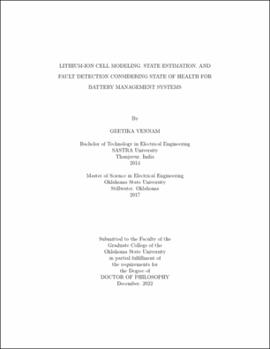| dc.contributor.advisor | Sahoo, Avimanyu | |
| dc.contributor.author | Vennam, Geetika | |
| dc.date.accessioned | 2023-07-05T20:56:49Z | |
| dc.date.available | 2023-07-05T20:56:49Z | |
| dc.date.issued | 2022-12 | |
| dc.identifier.uri | https://hdl.handle.net/11244/337879 | |
| dc.description.abstract | Lithium-ion batteries (LIBs) with high energy density and longer cycle life enable a comparable driving range per charge for electric vehicles (EVs) with their gas counterparts. However, the LIBs are very sensitive to variations in operating conditions, such as overcharge/discharge, high/low temperatures, and mechanical abuse. A battery management system (BMS) is employed to orchestrate safe and reliable operation by monitoring the voltage, current, temperature, state of charge (SOC), and state of health (SOH) and optimizing the charging and discharging cycles. The SOC and SOH, which determine the performance of the LIB, are governed by several stress-inducing factors, such as operating temperature, C-rate, aging, and internal faults. So, it is important to estimate the SOC and SOH in real time, considering the factors affecting the degradation of the battery. On the other hand, an internal fault in LIB leads to thermal runaway. Early detection and diagnosis of these faults are necessary to avoid catastrophic failures of LIBs. | |
| dc.description.abstract | In this dissertation, we developed health-inclusive dynamic models for simultaneous state and parameter estimations and fault detection (FD) schemes. First, we proposed a nonlinear parameter-varying equivalent circuit model (ECM) integrated with the parameter dynamics for simultaneous state and parameter estimation using nonlinear observer-based approaches. Second, the proposed model is extended to integrate the SOH and thermal behavior with ECM. The SOH-coupled nonlinear electric-thermal-aging model comprehends the interplay between the SOC and SOH and couples the ECM dynamics with capacity fade. The proposed model is further extended by integrating the ohmic resistance dynamics for simultaneous SOC, SOH, and parameter estimation using filtering algorithms. Finally, two FD schemes, based on the SOC-based and SOH-coupled models, are proposed to detect internal (thermal and side-reaction) faults by tracking the temperature and parameter residuals of the battery. Adaptive thresholds are designed to account for modeling uncertainties and the effect of degradation in the residuals and avoid false positives. In addition, a novel neural network-based observer is proposed to learn the fault dynamics and estimate the SOC, SOH, and core temperature under internal faults. Experimental and numerical validation results are presented to corroborate the designs. | |
| dc.format | application/pdf | |
| dc.language | en_US | |
| dc.rights | Copyright is held by the author who has granted the Oklahoma State University Library the non-exclusive right to share this material in its institutional repository. Contact Digital Library Services at lib-dls@okstate.edu or 405-744-9161 for the permission policy on the use, reproduction or distribution of this material. | |
| dc.title | Lithium-ion cell modeling, state estimation, and fault detection considering state of health for battery management systems | |
| dc.contributor.committeeMember | Yen, Gary G. | |
| dc.contributor.committeeMember | Nazaripouya, Hamid | |
| dc.contributor.committeeMember | Bai, He | |
| osu.filename | Vennam_okstate_0664D_17915.pdf | |
| osu.accesstype | Open Access | |
| dc.type.genre | Dissertation | |
| dc.type.material | Text | |
| dc.subject.keywords | battery management system | |
| dc.subject.keywords | fault diagnosis | |
| dc.subject.keywords | lithium-ion batteries | |
| dc.subject.keywords | neural networks | |
| dc.subject.keywords | state of charge | |
| dc.subject.keywords | state of health | |
| thesis.degree.discipline | Electrical Engineering | |
| thesis.degree.grantor | Oklahoma State University | |
